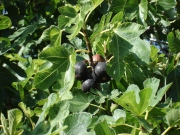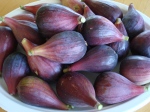
This is not really Cleopatra. This is Vivian Leigh. If you’ve seen busts and coins that show what Cleopatra really looked like…well, she must’ve had a really good personality.
Cleopatra says, “Oh, excellent! I love long life better than I love figs!” in Antony and Cleopatra (do you see me here, quoting Shakespeare??). Her enthusiasm (I mean, who doesn’t love long life?) for figs speaks to their appeal. Although, in this day and non-Mediterranean age and locale, there seem to be either fig lovers or fig…well,
haters seems a bit strong, so fig dislikers. Most people enjoy a Newton, but the fig relationship is snuffed out with the emptying of the package. We’ve always been big Fig Newton fans (big fans, not big Newtons, although big Newtons would be fine, too),
and we are blessed with a prolific fig tree in our yard, which was, back some many moons, a volunteer. A stray, if you will. The figs we grow are entirely organic (not exactly due to our commitment to the earth’s well-being, rather that the tree thrives on neglect), and quite large.  Some of them verge on being the size of a pear!
Some of them verge on being the size of a pear!
Every year the tree is very generous, giving enough not only for us, but also for the birds, the deer, and the rabbits, too. I like to use as many as possible fresh, but then I am
still left with a lot of unused figs. I bought a dehydrator, which is like a triple-decker cooling rack, except that it is enclosed and has a fan that blows warm air on the fruit. I have tried this many times and, sadly, have been left with tough little carcasses of figs, rather than the sticky lusciousness you get with a store-bought dried fig. So why keep trying it? Hope springs eternal, I guess (and yes, I do know the definition of stupidity). But this year I looked into it online, and on eHow I found a way to oven-dry the figs. It worked very well.
The first thing you do is to make sure all your figs are ripe, clean, and free of bird, uh, detritus. Then preheat the oven to 250 degrees. Cut off the stems, then slice all the figs lengthwise. Place the
figs, cut side down, in a shallow dish with sides. I used Pyrex 9x13s, and they worked well, but use a dish to fit the amount of figs you have, as the figs need to fit snugly in the dish. You need a pan with sides because the figs give off a lot of juice, and you want to contain it. Place the dish with the figs in the oven, and set the timer for one hour. After an hour, turn the figs over, cut side up. The juice should be starting to flow now, so kind of mop it up with the figs as you turn them over. Set the timer for another hour and repeat, this time turning the figs cut side down, mopping up the juice again. Set timer for an hour again, and turn figs
cut side up. If you have a lot of juice, tilt the pan and use a spoon to drizzle that juice over the figs. At the end of three hours, the figs will be dark, wrinkly, sticky, and fragrant. Reduce the heat to 200 degrees, and return the figs, still cut side up, to the oven for about 30 to 45 more minutes. That will allow the excess liquid to evaporate, the figs to dry somewhat, and the texture to become more like that of “real” dried figs. The whole process will have taken about three-and-a-half hours. Turn the oven off and allow the figs to cool down in the oven (I left them in the oven overnight and it was fine).
These figs stay quite moist, so I would store them in the fridge for short-term use, or freeze them for longer storage.
This isn’t exactly a cost saving recipe–the oven is on for a very long time. But what you do get is some tasty, nutritious dried fruit that is prepared with absolutely no chemicals or preservatives. I made fig bread, which was delicious toasted with either brie or blue cheese on it, and will be making fig bars soon.
Apparently figs were one of the first foods cultivated for agriculture, 11,000 years ago in the Middle East, according to Wikipedia. I don’t understand why they are not used today to help solve hunger problems. While they do need some winter rain, they don’t need any water for about 9 months out of the year, and they seem to self-sow. In addition, they produce two crops every year, one in June and the other in about August–there are huge amounts of fruit! I would think some poverty-stricken areas in the world could use a few fig trees to help alleviate some of their problems. Figs are very high in sugar, which would surely be a boon to starvation-prone areas. They even have a little protein in them!
Well, I’m off to dry another batch, and then I will wait for the second crop to ripen. And so it goes.






